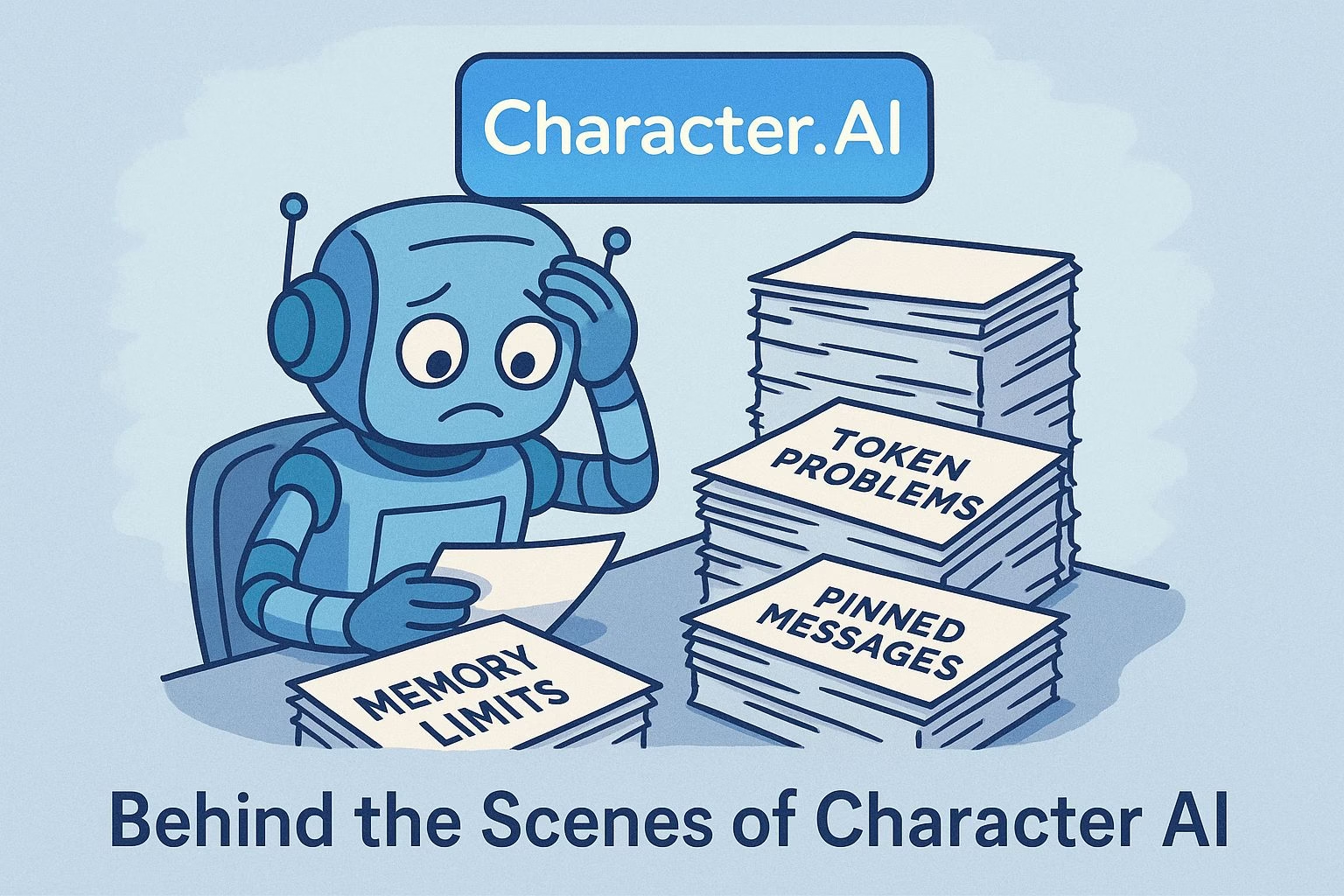The Hidden Problems That Limit Character AI Bots
If you have spent any real time with Character AI, you probably know the feeling.
One moment you are having a perfect, immersive conversation with your favorite bot, and the next it derails into weird memory lapses, awkward references, or straight-up confusion.
Despite the platform’s sleek marketing and promises of intelligent roleplaying companions, there is a much messier story underneath.
After months of digging through official documentation, user reports, and hands-on testing, it has become clear that the biggest barriers to quality experiences on Character AI are not just bad bots or user error.
They are built into the platform itself.
We’ll break down:
-
Why pinning messages is not as effective as it seems
-
The real story behind the memories system and who really benefits from it
-
Hidden limitations in character creation most users never realize
-
How canon characters dominate the marketplace while original characters struggle
-
What the Soft Launch model reveals about Character AI’s future
-
Why the platform’s focus on monetization could be holding everyone back
Whether you are a casual user frustrated by shallow conversations or a serious creator trying to optimize your bots, understanding these hidden mechanics will save you countless hours of trial and error.
I will also mention a few alternatives, like Candy AI, that are beginning to rethink how these features should actually work.pro
The Reality Behind Pinned Messages
On paper, Character AI makes pinning messages sound like a simple solution for keeping conversations coherent.
Users are told they can pin important information to help bots stay in character and maintain context across long chats. But anyone who has worked closely with the platform knows the reality is much messier.
Technically, you can pin up to 15 messages. In practice, the system starts to break down after just five to seven short pins, especially if those pins are longer than a few hundred characters each.
This is not a rumor or user myth. It is a direct result of how the platform’s token economy actually works behind the scenes.
Each conversation has a total memory capacity of around 3,000 to 4,000 tokens, and pinned messages consume that memory just like anything else you say.
Stack too many pins, and the AI starts clinging obsessively to them, ignoring newer conversation details.
Bots may even derail mid-conversation to reference something pinned dozens of messages ago, often in ways that make the interaction feel stiff, unnatural, or repetitive.
This problem, often called pin amnesia by users, is not a rare glitch.
It is a predictable outcome of how the platform was built.
Bots prioritize pinned messages heavily, even when it means throwing out more recent, relevant context. Instead of enhancing your chats, pinning too aggressively can actually kill the flow altogether.
The smarter approach is pinning sparingly and focusing only on traits absolutely critical to the bot’s identity.
Writing pins as direct commands rather than casual notes tends to work better, helping the AI understand priorities without getting bogged down by unnecessary noise.
Auto Memories A Useful Idea Poorly Executed
When Character AI rolled out its Auto Memories feature for premium users, it was framed as a major breakthrough.
Finally, bots could start remembering key details without needing users to constantly pin information manually.
At least, that was the sales pitch.
In reality, Auto Memories are far less dependable than advertised. Bots do not even begin forming memories until 40 or more messages into a conversation.
Even then, memory formation is inconsistent, sometimes working well, sometimes ignoring important details completely.
Even with the April 2025 update that added editing capabilities, memories still behave unpredictably.
They tend to favor character-specific facts over dynamic user-driven events. Your bot might remember that it loves gardening but forget the important adventure you two shared yesterday unless you remind it constantly.
It is also worth noting that memory quality varies depending on the underlying model. Some bots improve significantly over time, while others remain frustratingly forgetful no matter how carefully you craft your conversations.
From a business standpoint, locking this functionality behind the c.ai+ paywall makes sense. But from a user perspective, it feels restrictive.
At minimum, there should be a basic version available to all users, with advanced editing tools reserved for subscribers.
Instead, free users are left struggling with the original flawed memory system, making it harder for the broader community to enjoy meaningful, lasting interactions.
The Truth About Character Definitions
When you build a character on Character AI, the interface gives you a massive 32,000 character limit for the definition.
It feels like an open invitation to pour your heart into a detailed background, full personality traits, backstory, habits, and quirks.
But here is the catch most people never realize.
Only the first 3,200 characters actually matter.
After that, the platform’s models start losing interest in your text. Content beyond the 3,200 mark gets treated like background noise.
You could spend hours carefully writing an extra 20,000 characters, and it would barely move the needle on performance.
What matters most is not just how much you write. It is where and how you place key information.
The first 1,000 characters should focus heavily on essential traits, behaviors, and interaction style. After that, the platform pays close attention to the first 15 to 30 example dialogues you provide.
These examples shape how the bot responds far more than any long-winded description.
There is also a technical trick that makes a difference. Formatting example dialogues using the {{char}} prefix helps signal to the AI that it is looking at examples to follow.
When you focus on showing personality through real dialogue instead of stacking endless descriptions, your bot becomes sharper, more consistent, and much more natural in conversations.
The frustrating part is that Character AI does not make any of this clear.
They let people believe the full 32,000 characters have weight, encouraging creators to waste hours polishing sections that ultimately have little or no impact.
Original Characters Struggle to Compete With Canon Bots
Spend even a little time browsing Character AI’s most popular bots and a pattern becomes obvious.
Characters based on famous franchises dominate the charts. Meanwhile, original creations often struggle to even get noticed.
This is not just about quality.
Canon bots succeed for reasons that have nothing to do with how well they are written. They benefit from built-in audience recognition, lower user expectations, and early-mover advantage.
People searching for familiar names are more forgiving of weird behavior because they already have an emotional connection with the character.
Character AI’s recent update adding better search filters does help a little. It gives new or high-quality OCs a slightly better shot at discovery.
But the platform still heavily favors recognizable names. It is an uphill battle for creators who want to build something fresh and unique.
If you are making an original character, the smartest move is to go all-in on distinct personality traits and memorable quirks. Think about interaction patterns that make your OC feel alive, not just a blank slate bot.
If you are building a canon bot, you need to put extra effort into replicating canon behavior through your example dialogues, not just leaning on the character’s name.
What the Soft Launch Model Reveals About the Platform’s Direction
Character AI’s introduction of the Soft Launch model signaled a major shift in how the platform is thinking about content control and user experience.
Soft Launch bots behave differently from the standard models. They are less strict about content filtering, more expressive emotionally, and more spontaneous in conversations.
At the same time, they tend to be less observant of subtle conversational details and more prone to drifting off-topic during longer chats.
When you compare Soft Launch bots to older models like Nyan or Roar, the differences are clear.
Nyan tends to over-filter content and get stuck in rigid patterns, while Soft Launch allows for much freer dialogue, even if it sometimes sacrifices coherence.
Roar models are better at sticking to a story but still feel a little too cautious compared to Soft Launch’s more relaxed tone.
The takeaway is simple. Character AI is testing how far they can push looser content restrictions without drawing regulatory backlash or alienating users.
Unfortunately, Soft Launch does not fix deeper technical problems. Bots still suffer from memory loss over time, and token limitations still force conversations into weird resets.
This suggests the platform’s real issues are built into the core architecture and will require much bigger changes to truly fix.
Platform Trends Show Where Priorities Really Lie
If you watch Character AI’s update history closely, a clear pattern emerges.
Most major changes over the last year have focused on five areas:
-
Adding new monetization features like c.ai+ exclusives
-
Improving content moderation tools
-
Boosting user retention
-
Updating the interface
-
Slowly upgrading core AI capabilities
Notice what is missing.
There has not been a serious effort to fix memory limits, improve token handling, or overhaul character processing. Instead, surface-level improvements take priority, leaving core frustrations intact for users and creators alike.
This strategy makes sense from a business standpoint. Polishing the interface is an easier sell to investors than admitting fundamental technical weaknesses.
But for people who care about real conversations and character depth, it is frustrating.
Memory constraints, broken pins, shallow behavior, these issues still define much of the experience, no matter how clean the interface looks.
Platforms like Candy AI, although newer, seem more honest about the trade-offs they make. They offer a different approach that feels less focused on monetization tricks and more on giving users straightforward experiences.
Where Things Are Headed and How to Adapt
Character AI’s development strategy shows that while innovation is happening, it often prioritizes growth over solving deep issues.
That leaves users and creators stuck adapting to platform limits instead of being empowered by real improvements.
For developers, the path forward should be obvious:
-
Be honest about token and memory limits
-
Provide a basic memory system for all users
-
Offer better analytics for creators
-
Invest seriously in fixing core memory and token issues
Until that happens, the burden falls on the community. Creators must work smarter within real limits, focusing on short, highly effective definitions and managing conversations tightly.
Users must adjust expectations and learn conversation techniques to guide bots more carefully.
And when better alternatives like Candy AI appear, users should not hesitate to explore them if Character AI continues to resist fixing its foundations.
Conclusion
Character AI remains an impressive platform, but it is deeply flawed beneath the surface.
While new models and updates create the appearance of progress, the real limitations, memory loss, token economy issues, and character definition gaps continue to affect every interaction.
For casual users, it is easy enough to enjoy the platform within its limits. For serious creators and roleplayers, understanding these hidden mechanics is essential.
It allows you to create better bots, manage your expectations, and explore alternatives when necessary.
The future of Character AI depends on whether the developers decide to move beyond surface-level polish and start fixing the problems that actually matter to the people using the platform every day.

